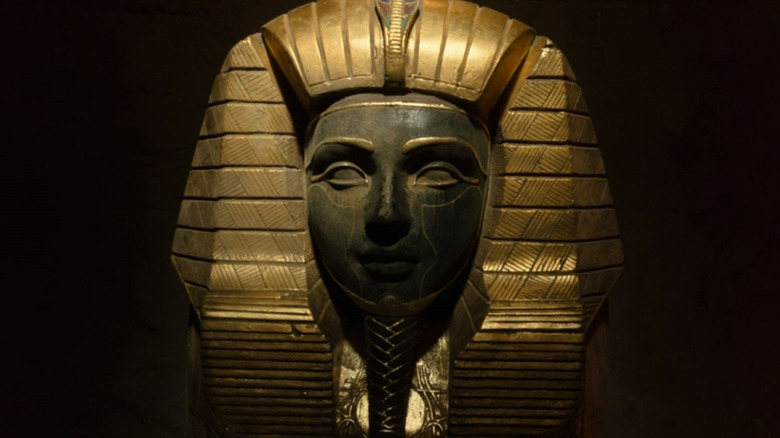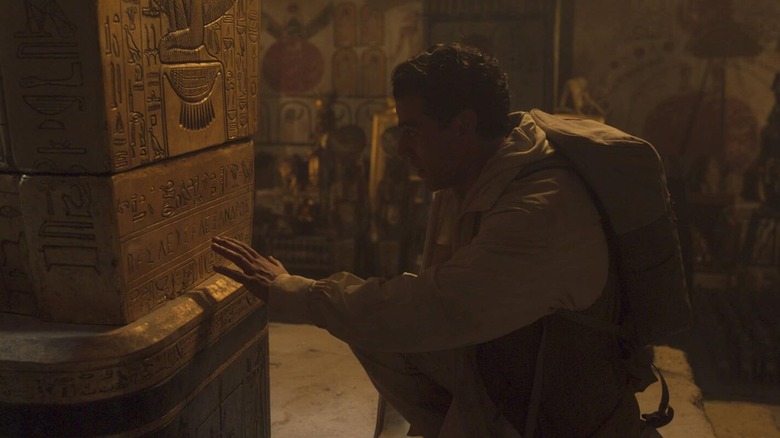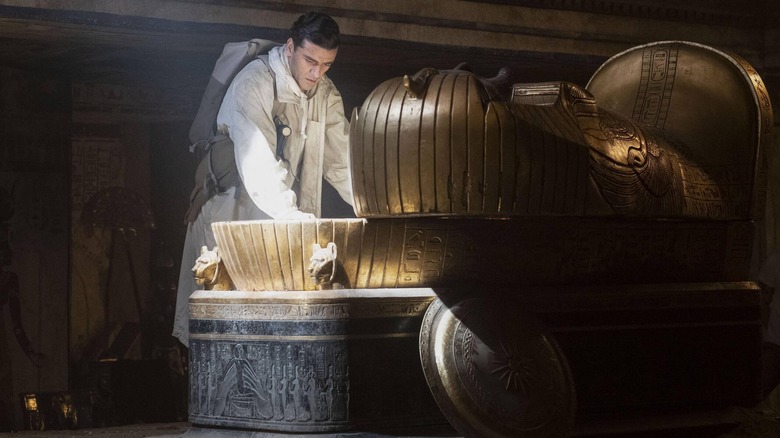Let's Talk About Who Was Inside That Sarcophagus In Moon Knight Episode 4
"Moon Knight" is one of the most interesting Marvel projects to date — a deeply weird, complex show that is constantly changing genres, and adding layer upon layer of mystery. The fact that the show shares so little connective tissue with the larger MCU that even placing it within the franchise timeline is hard makes helps make it stand out. Free from having to justify itself within the context of other stories, "Moon Knight" can focus on better things, like adding easter eggs to Egyptian mythology and history, of course.
Arguably the biggest easter egg has been the constant teasing of a third party involved in the conflict between Steven (Oscar Isaac) and Marc (Oscar Isaac), who are constantly fighting over their shared body. This week, that mystery thickened as Steven and Layla (May Calamawy) find the tomb of Ammit. Inside, they find a big sarcophagus hiding a big secret, and a mythic character that some fans may have predicted, but nevertheless got a surprise name-drop.
A shocking reveal
The episode brings to mind the best of 1999's "The Mummy," with plenty of puzzle-solving and ghoul-fighting. At the end, we see a sarcophagus in an empty room, one that has Steven absolutely perplexed just from looking at it, and with good reason.
We do get some misdirection about who may be inside, with elaborate decorations including references to Nefertiti and Thutmose II, but when we see a big bronzed stallion (Bucephalus) and Macedonian scripture, the history nerd Steven is convinced. This is none other than the final resting place of a man who, while not born in Egypt, was still proclaimed a pharaoh. Indeed, this week's "Moon Knight" solves one of the biggest mysteries not just in the MCU, but in the real world, by revealing the long-lost tomb of Alexander the Great.
"Moon Knight" spends an extended sequence with Steven shoving his arm down Alexander's throat (apologizing to him and calling him "Mr. Great") because that's where he would hide Ammit's ushabti.
A more exciting secret history
In reality, Alexander's tomb is indeed lost, and we don't even know for sure how he died. His body was placed in a gold sarcophagus, but it was stolen on its way to a burial place by one of his generals and buried in Egypt, after which it was transferred once again to the city of Alexandria in Egypt. With time, and multiple natural disasters, parts of the city were lost, including Mr. Great's tomb. Even today, there are over 100 officially-sanctioned digging sites looking for the tomb.
What makes this episode of "Moon Knight" great is that it not only uses this actual lost tomb for its story, but that it makes Alexander an avatar of Ammit. That this brilliant strategist and conqueror also had the powers of a god that judged people's moral worth is not only makes some sort of wicked sense, but it is just the sort of nonsense historical fiction that makes movies like "National Treasure" or games like "Assassin's Creed" so entertaining. It plays with the idea that there is a hidden side to history that we've never heard of, that these historical figures that whole other sides to them that historians never saw, that secret societies and gods walked around us with normal folks not realizing it.
If Alexander was the avatar of Ammit, then who is to say Julius Caesar wasn't also the avatar of some god? The sarcophagus is now open, and it cannot be closed again.
"Moon Knight" streams new episodes on Wednesdays on Disney+.


